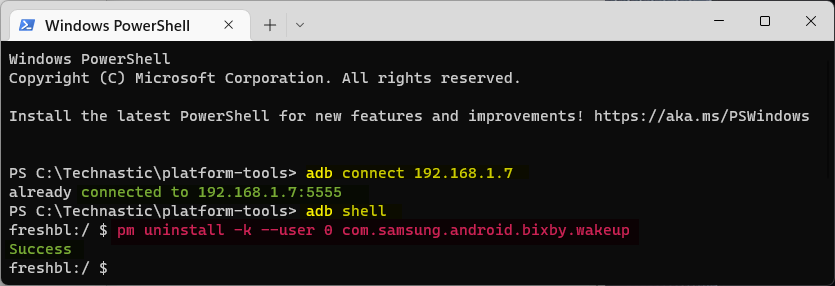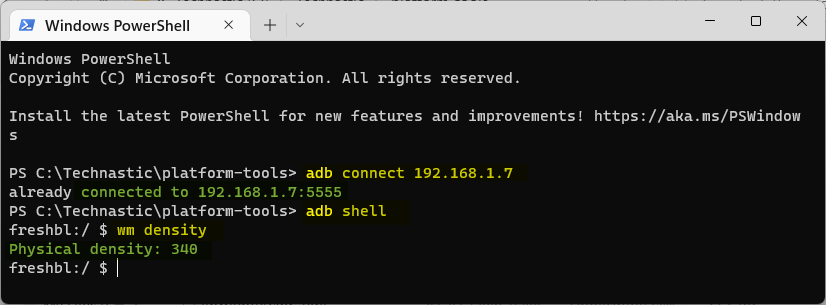Using ADB, you can install and uninstall apps, push and pull files, customize watch settings, and do several other things. Since the Wear OS watches don’t have a USB-C port, you can connect them to ADB over Wi-Fi. In this tutorial, we’ll check out how we can use ADB commands on Wear OS watches like the Samsung Galaxy Watch 5, Google Pixel Watch, and so on.
List of Wear OS ADB Commands
Having set up ADB over Wi-Fi on your watch, you can do several things using ADB commands such as installing and uninstalling apps, pushing and pulling files, changing font size, and customizing settings. From this point onward, I’ll presume your watch is connected to ADB wirelessly.
Install APK on Wear OS
If you want to install an app unavailable on the Play Store or restricted in your region, you can sideload its APK via ADB. The ADB install command for Wear OS lets you install or sideload apps.
- Download the APK file for the app you want to install on your device and transfer it to the platform-tools folder.
- Type the following command in the given format.
adb -s <ip> install <apk-name-with-extension>
- For example, if your IP address is 192.168.1.11 and the name of the APK is Phone.WearOS.SHM.MOD.apk, the command would be as follows.
adb -s 192.168.1.11 install Phone.WearOS.SHM.MOD.apk
- Having typed the command, press the Enter key.
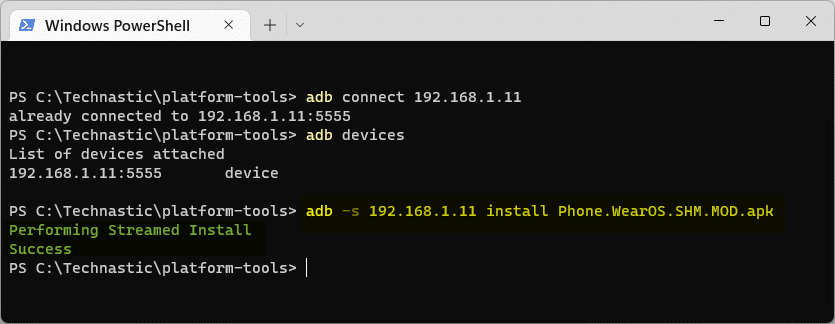
- The app will be installed on your watch. You can install any APK using the ADB command given above.
Uninstalling Apps on Wear OS
One of the perks of ADB commands is that they let you uninstall system apps on Android without root access. If you want to debloat your watch, use the steps below.
- Enable ADB on your watch and connect it to ADB using
adb connect <ip>. - Now type the following command and hit Enter to invoke the shell mode.
adb shell
- Once the connection is turned into the ADB Shell mode, type one of the following commands to get a list of apps installed on your Wear OS watch.
pm list packages (List all apps)
pm list packages -s (List system apps only)
pm list packages | grep 'samsung' (List apps by group)
- You’ll get the list of apps. Below is a screenshot showing the list of system apps installed on the Galaxy Watch 6.
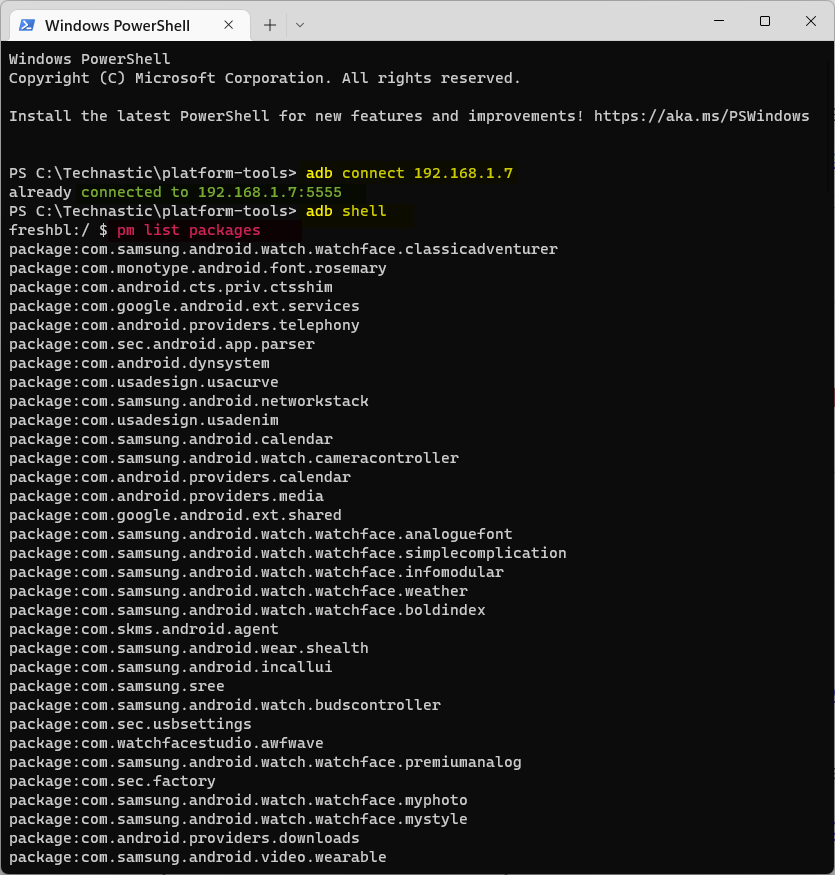
- Now that you have the full list of apps installed on your watch, you can easily get the app package name for the app you want to uninstall.
- Type
pm uninstall -k --user 0 <package name>and press Enter to uninstall any app from your watch. For example, if you own a Samsung Galaxy Watch 6 and want to uninstall the Bixby Wake-up app, use the command as follows. The ‘-k’ parameter means “keep data’ of the uninstalled app. To delete app data, remove the parameter.pm uninstall -k --user 0 com.samsung.android.bixby.wakeup
You can not only install and uninstall apps using ADB commands, but also disable and reinstall them.
- Disable an app:
pm disable-user --user 0 <app-package-name> - Enable a disabled app:
pm enable --user 0 <app-package-name> - Reinstall an uninstalled app:
pm install-existing <app-package-name>
Push and Pull Files
Wear OS watches have internal storage for storing files, but the lack of a USB port makes it impossible to transfer files to the device from a PC. Thanks to the ADB, we can push files to the watch and pull files from it using commands.
Pulling Files from Wear OS
You can pull any file or app from your Wear OS watch and save it to your PC. For example, to pull an app from your watch, do as described below.
- Ensure that your watch is connected to your PC via ADB.
- Type the following command and press Enter.
adb shell
- When ADB enters the shell mode, execute the
pm list packagescommand to get the list of all apps. Copy the app package name you want to pull. - Now type the command below, followed by the app package name, to get the path of the app.
pm path <app-package-name>
- You will see the location path of the app package printed in the command window. Copy it.
- Finally, execute the following command to pull the app APK file from your watch to your computer.
adb pull <path-to-app-package>
- The pulled APK file will be saved to the platform-tools folder.
Pushing Files to Wear OS Watch
While it’s easy to set a custom ringtone on an Android phone, the same is not true about a Wear OS watch. Thanks to the adb push command, you can transfer an MP3 file to your smartwatch and set it as a ringtone. Do the following to set a custom ringtone, notification, or alarm tone on your watch. If you want to push any file to your smartwatch, this is how you can do it.
- I presume that your Wear OS watch is already connected to ADB.
- Download the MP3 file and transfer it to the platform-tools folder. Suppose you have to set the Believer song as your watch’s ringtone; use the following command to push it. Don’t forget to replace “Believer.mp3” with the name of the MP3 file you want to push.
adb push Believer.mp3 /sdcard/Ringtones/ - In case you also want to change the notification and alarm tones, you can use the following commands.
adb push Believer.mp3 /sdcard/Notifications/
adb push Believer.mp3 /sdcard/Alarms/
- Once the MP3 file is transferred to your smartwatch, restart it.
- When your watch boots up, open Settings and go to Sounds and vibration > Ringtone.
- Select the transferred audio file from the list to set it as your ringtone.
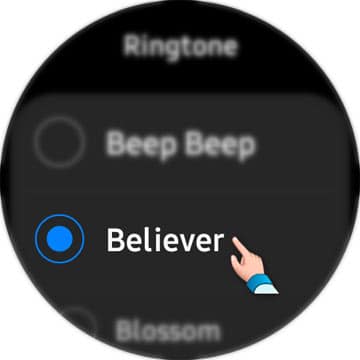
Changing Font Size in Wear OS
ADB commands can also help you customize the user interface elements, such as font size and display density. If you want to change the font size of your Wear OS watch, you can easily make it smaller or larger by changing the value.
- Switch to the shell mode by executing the following command.
adb shell
- To find out the current font size of the font on your smartwatch, type the following command and hit the Enter key.
settings get system font_scale
- As you can see, the font size on my Samsung Galaxy Watch 5 is 1.1. If I want to make the font larger or smaller, I’ll have to change the value accordingly. Depending on your preference, you can select one of the following values to set the font size.
Smaller: 0.80
Default: 1.0
Large: 1.2
Largest: 1.3
- Thus, if you want to enjoy a larger font on your Wear OS watch, try the following value.
settings put system font_scale 1.15
Change the Display Size or DPI in Wear OS
By changing the DPI or display density, you can force your Wear OS watch to show more content on the display. While changing the font size only makes the device font bigger or smaller, adjusting the display density or DPI changes the size of all UI elements. With smaller density, you can accommodate more content on the compact screen of your Wear OS watch. Let’s see how to do it.
-
- Connect your watch to your computer via ADB over Wi-Fi.
- Verify the connection using the
adb devicescommand. - Then execute the following command.
adb shell
- To find the current or default display density of your watch, type the following command and hit Enter.
wm density
- The command prompt window will show the current display density, which, in my case, is 340.
- If you want your watch display to accommodate more content, you can change the value to 300, 240, or even 200. To change the display size, execute the following command.
wm density 240
- Below is a screenshot showing how the display of my Samsung Galaxy Watch 5 looks with the 340 (default), 300, and 240 display densities.
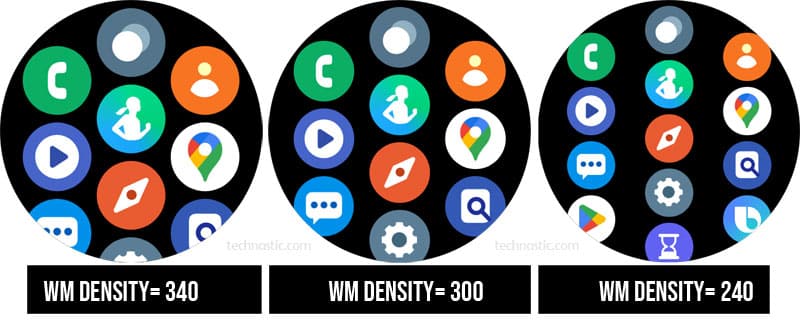
- To revert to the default display density on your Wear OS watch, run the following command.
wm density reset
That’s all for now! I’ll keep updating this tutorial with new Wear OS ADB commands. Try them on your watch and let us know if they worked for you. In case you need any help, please drop a comment below.
Read Next: How to Enable or Disable Watch only Mode on Galaxy Watch

